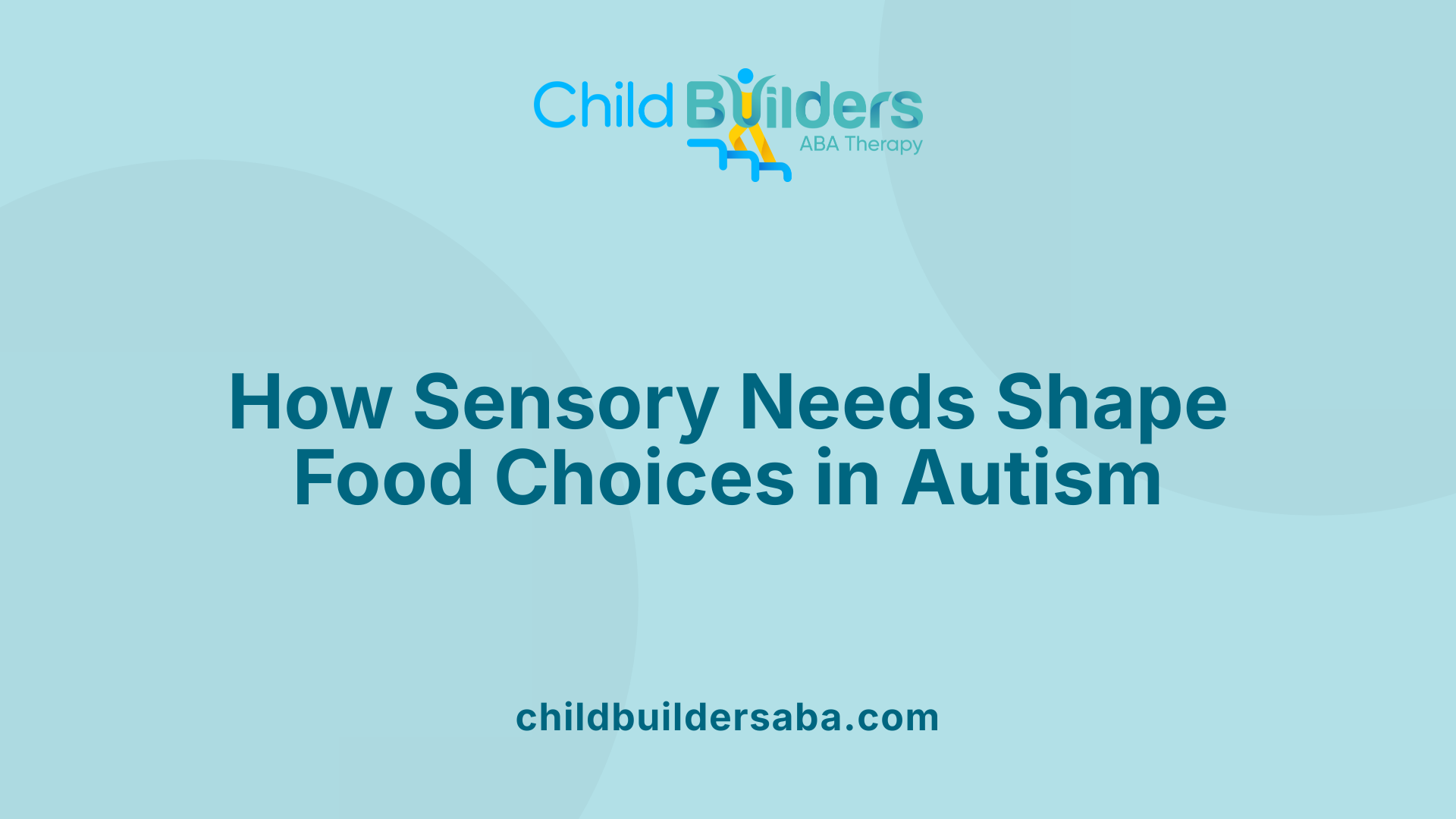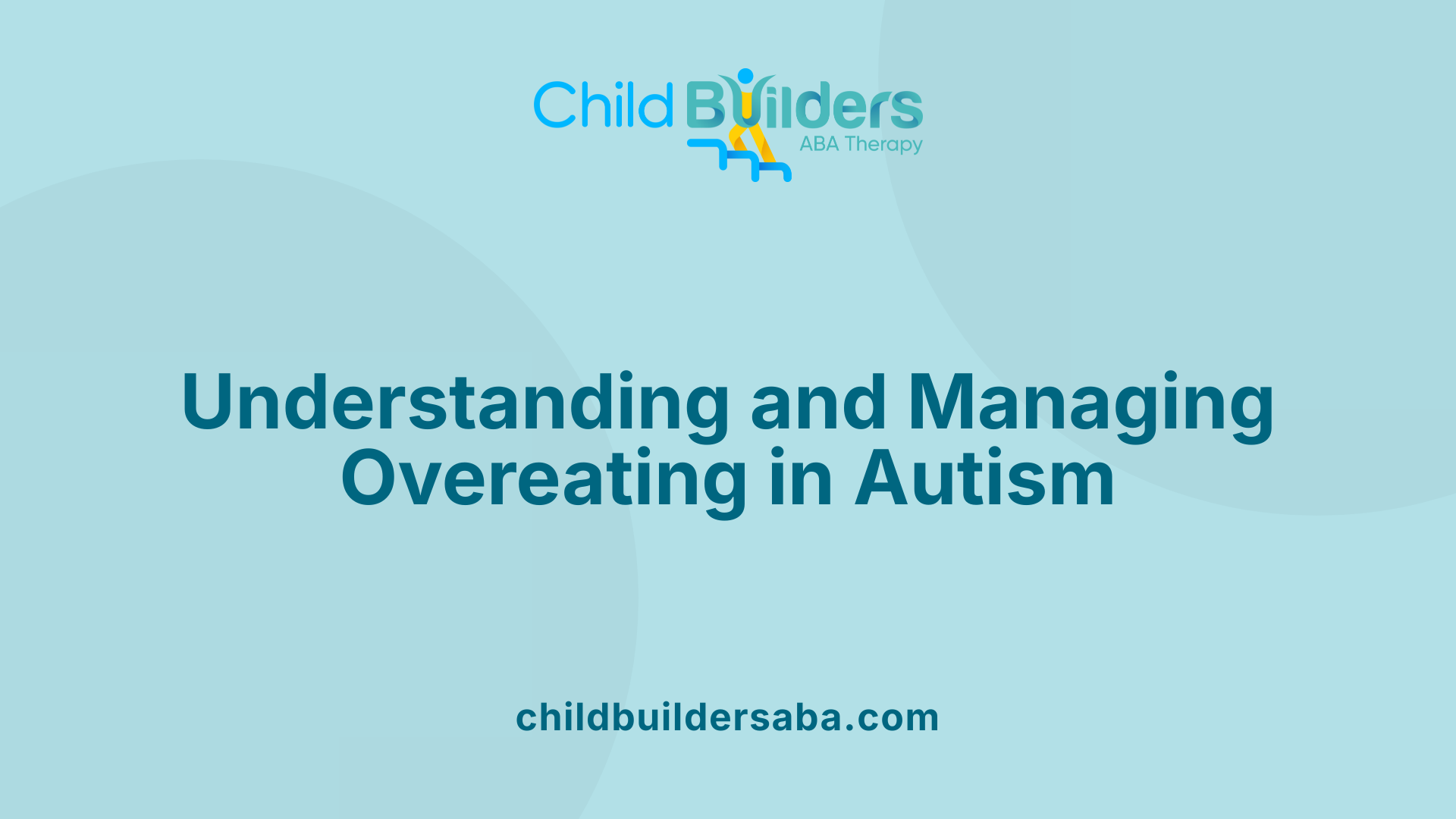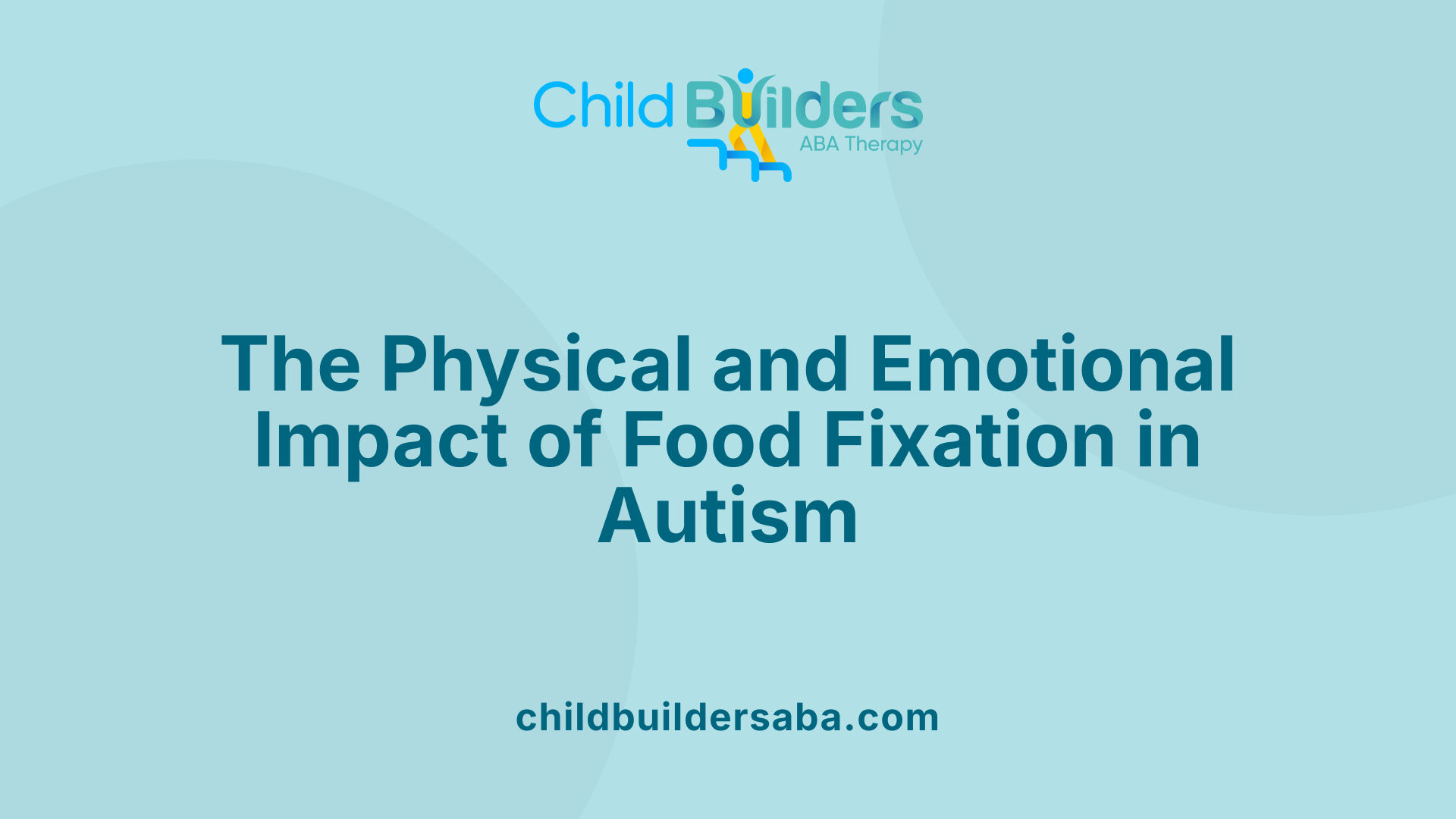Autism And Food Obsession

Exploring Food Preferences, Obsessions, and Management Strategies in Autism
Autism spectrum disorder (ASD) presents unique challenges and behaviors related to food, sensory sensitivities, and eating routines. This comprehensive overview delves into why autistic individuals often develop intense food preferences or obsessions, the underlying causes, and effective strategies for support. By understanding these behavioral patterns, caregivers, educators, and healthcare professionals can better manage and support the nutritional and emotional well-being of autistic individuals.
Sensory Sensitivities and Food Preferences in Autism

Why does my autistic child want to eat all the time?
Many children and adults with autism tend to want to eat frequently, a behavior often rooted in the way they process sensory information. Food can serve as a source of comfort or sensory stimulation, fulfilling needs related to texture, flavor, or biting sensations. Stress, anxiety, and sensory processing differences play significant roles in this ongoing desire to eat.
Factors such as restricted diets, oral-motor challenges, and side effects from medications can further influence eating patterns, sometimes leading to overeating or eating beyond hunger. As children with autism grow older, decreased physical activity and metabolic changes might contribute to weight gain.
Managing these eating behaviors involves structured routines, offering alternative sensory or movement activities, and consulting healthcare professionals to promote healthier habits. These steps can help balance the child's sensory needs with nutritional wellbeing.
Is overeating a symptom of autism?
Overeating among autistic individuals can indeed be linked to specific behaviors like hyperphagia—an uncontrollable desire to eat beyond true hunger. Sensory sensitivities and oral-motor difficulties often contribute to these habits. For many, food becomes a source of comfort or a way to self-soothe, especially when under stress or overwhelmed by sensory input.
Other factors, such as reduced physical activity, side effects of medications, and irregular mealtimes, can also promote overeating. Research indicates that weight gain and obesity are more prevalent in children with autism compared to their neurotypical peers, highlighting the importance of managing eating habits effectively.
Addressing overeating requires a comprehensive approach, including behavioral strategies, consistent routines, and medical guidance, to support healthier eating patterns.
Do autistic individuals fixate on food?
A significant number of autistic individuals exhibit fixation on food or restrictive eating behaviors. Studies show that around 70% of children with autism may display some form of food obsession, such as extreme selectivity, repetitive eating patterns, or focusing intensely on particular foods.
These fixations manifest differently across individuals—some may have rigid routines around their food choices, while others might show compulsive behaviors like collecting or obsessing over specific textures or flavors.
Interventions such as Applied Behavior Analysis (ABA) employ positive reinforcement, gradual introduction of new foods, and other strategies to mitigate these behaviors. While food fixation is a common characteristic, tailored behavioral approaches can help manage and reduce the intensity of these obsessions.
What is food rumination in autism?
Food rumination in autism involves involuntary or repetitive regurgitation of swallowed food and stomach contents. This behavior can be linked to sensory stimulation or gastrointestinal issues common in autistic individuals, such as acid reflux or esophageal irritation.
Symptoms might include chewing on clothing, excessive chewing, or behaviors like prolonged eating episodes and difficulty swallowing. These signs often indicate underlying gastrointestinal discomfort.
Managing food rumination involves addressing the gastrointestinal issues—using medications like antacids or therapies to improve gastric emptying—and implementing behavioral strategies. Proper management of reflux and related discomfort is crucial for overall well-being and to reduce behavior patterns tied to GI discomfort.
How do sensory sensitivities impact food choices?
Sensory sensitivities profoundly influence food preferences in autism. Many individuals prefer foods with specific textures, flavors, or consistencies, such as soft, chewy, crunchy, or bubbly foods.
For example, some might favor carbohydrates and processed foods while rejecting fruits and vegetables. This selective eating can lead to nutritional deficiencies, impacting health over time.
Strategies to manage these preferences include introducing new foods gradually, building on existing favorites, and using foods with intense but appealing tastes like spicy or sour flavors. Sensory input can be varied by offering textured foods or using tools like gum or chewy tubes to satisfy oral-motor needs. Moreover, managing sensory overload with calming techniques, such as deep pressure or calming sounds, helps reduce distress around eating.
How does the preference for specific food types affect nutrition?
Many individuals with autism show a strong preference for processed foods and carbohydrates while avoiding fruits and vegetables. This restrictive diet can result in nutritional deficiencies, such as lacking essential vitamins and minerals.
Additionally, the reliance on calorie-dense processed foods may contribute to weight gain or obesity, which is more common in autistic populations.
To address these issues, gradual introduction of diverse foods, nutritional supplements, and professional dietary guidance are recommended. Encouraging variety and managing sensory sensitivities can improve overall nutrition.
| Aspect | Description | Impact/Strategies |
|---|---|---|
| Food fixation | Focused obsession with specific foods | Use positive reinforcement, gradual food diversity |
| Overeating | Excessive intake beyond hunger | Regular routines, behavioral management, medical consultation |
| Sensory preferences | Preference for certain textures and flavors | Introduce new foods slowly, sensory-based approaches |
| Nutritional risks | Deficiencies and weight issues | Professional dietary guidance, nutritional supplements |
This comprehensive understanding of sensory sensitivities and food preferences in autism highlights the importance of personalized strategies to support healthy eating behaviors and nutritional health.
Behavioral Strategies to Manage Food Obsessions

Why does my autistic child want to eat all the time?
Children with autism often display frequent eating behaviors because they use food as a self-soothing tool and to fulfill sensory needs. For many, specific textures, flavors, or biting sensations provide comfort and help regulate their sensory environment. Stress, anxiety, and differences in sensory processing can make eating an appealing way to manage overwhelming feelings or internal discomfort.
Other factors that influence eating patterns include restrictions in diet, oral-motor challenges impacting chewing and swallowing, and side effects from medications that may increase appetite. As children grow, decreased physical activity and metabolic changes might contribute further to weight gain and overeating. Understanding these underlying causes is crucial for effective management.
Implementing structured routines, offering alternative sensory activities, and consulting healthcare providers like pediatricians or dietitians can support healthier eating habits and reduce compulsive eating. Creating a predictable and calming mealtime environment helps children feel secure and less inclined to seek food constantly.
Are there strategies to reduce food fixation and promote varied eating?
Yes, there are several proven strategies to help children with autism expand their food choices and decrease fixation behaviors. Establishing visual schedules and consistent routines before and during meals increase predictability, reducing anxiety about trying new foods.
Gradually introducing new foods in small steps—such as offering a new fruit alongside a preferred one—encourages acceptance without overwhelming the child. Building on existing preferred foods by altering textures or flavors gently can also facilitate diversification.
Encouraging flexibility during mealtimes is essential. This involves reducing pressure to eat and avoiding conflicts over food, which can worsen fixation behaviors. Instead, creating a fun and relaxed environment—like involving children in food preparation or sensory play—can foster curiosity and willingness to try new foods.
Using positive reinforcement, such as praise or rewards for attempting new foods, motivates children without creating stress or resistance. Additionally, engaging sensory activities like tasting or smelling different foods in a playful manner helps children become more comfortable with a broader dietary range.
Strategies to manage food obsession and emotional triggers
Many children with autism develop food fixations due to emotional needs or sensory sensitivities.
Addressing emotional triggers involves recognizing when stress or anxiety influences eating behaviors. Techniques such as deep breathing, physical movement, listening to calming sounds, and applying gentle deep pressure can help soothe overwhelmed children.
Providing alternative sensory input—like textured toys, chewy tubes, or using chewing gum—can satisfy oral-motor needs without relying solely on food. Incorporating these strategies into daily routines supports emotional regulation and reduces obsessive behaviors.
Managing overeating in autistic children and teenagers
Overeating can stem from habits, sensory needs, or emotional factors. Keeping snack foods out of reach, replacing snacking with engaging activities, and maintaining regular, predictable mealtimes help create a structured environment.
Managing sensory sensitivities by offering foods with specific textures or flavors that children find comforting can prevent overconsumption driven by sensory craving. Addressing emotional influences by creating safe, routine-based environments reduces anxiety related to eating.
If overeating impacts health or becomes difficult to manage, consulting healthcare professionals—GPs, pediatricians, or dietitians—is advisable. They can provide tailored strategies and support for developing healthier eating patterns.
Addressing eating disorders among autistic individuals
Research suggests that autistic individuals are at a higher risk of developing eating disorders. Between 4% and 23% of those with eating disorders are also autistic.
Anorexia appears to be the most common among this population, often intertwined with strong food preferences, ritualistic routines, and control needs.
Contributing factors include sensory sensitivities, obsessive focus on food, strict routines regarding food and exercise, and attempts to manage difficult emotions. Some individuals also use specific eating behaviors, like slowly consuming a lollipop or sipping through a straw, as forms of sensory self-stimulation.
Addressing these disorders requires understanding the underlying sensory and emotional factors. Therapeutic interventions focusing on flexibility, emotional regulation, and sensory processing can be effective.
Sensory-based coping strategies and alternative behaviors
Some autistic individuals find relief through sensory stimulation or self-soothing behaviors involving food. For example, slow consumption of a candy or sipping through a straw provides sensory input with minimal caloric intake.
Healthier options, such as intensely flavored foods—think spicy, sour, salty, or bitter—and textured foods like crunchy or chewy options help satisfy sensory cravings.
Other strategies include:
| Technique | Purpose | Example |
|---|---|---|
| Clearing residual flavor | Reduces lingering tastes | Drinking water or chewing gum |
| Mouth and jaw movement | Satisfies oral-motor needs | Chewing chewy tubes or gum |
| Deep pressure | Manages sensory overload | Using weighted blankets or applying gentle pressure |
Implementing these behaviors can reduce reliance on food for sensory or emotional needs.
Additional stress management techniques
Managing stress and sensory overload in autism extends beyond food-related behaviors. Techniques such as deep breathing exercises, physical activities, listening to calming sounds, and applying deep pressure are effective methods.
Providing a calming environment and routines helps children feel secure. When stress or anxiety becomes overwhelming, these alternatives can soothe agitation and promote emotional balance.
Summary Table of Strategies
| Strategy | Focus | Example |
|---|---|---|
| Visual schedules | Food routines | Picture charts indicating meal times |
| Gradual food exposure | Expand variety | Introducing new foods slowly |
| Positive reinforcement | Motivate trying new foods | Praising or rewarding effort |
| Sensory input | Satisfy sensory needs | Chewy toys, textured foods |
| Emotional regulation | Reduce stress | Deep breathing, calming sounds |
| Structured routines | Decrease anxiety | Consistent mealtimes |
By applying a combination of these approaches, caregivers can support healthier eating behaviors, reduce fixation, and promote emotional well-being for individuals with autism.
Addressing Overeating and Sensory Overload

How can conditions like hyperphagia and emotional eating triggers be managed?
Autistic individuals, especially children and teenagers, are often prone to overeating or emotional eating, which can be driven by sensory sensitivities, habits, and emotional states. Hyperphagia, or excessive hunger, may be linked to medications that increase appetite or habitual snacking behaviors. Emotional triggers such as stress, anxiety, or difficulty managing feelings can also lead to uncontrolled eating. To address these challenges, creating a structured environment is crucial. Establishing consistent mealtimes helps regulate appetite and reduce impulsive eating. Keeping snack foods out of reach prevents unplanned snacking, while replacing snacks with engaging activities or sensory alternatives can redirect focus away from food. Additionally, teaching emotional regulation and stress management techniques, like deep breathing or mindful activities, supports better control over eating urges.
How can creating structured mealtimes and snack routines help?
Structured routines around eating provide predictability and security for individuals with autism. Regularly scheduled mealtimes reduce uncertainty and help establish healthy eating habits. When snacks are incorporated consistently—such as designated snack times—and foods are kept accessible only during these periods, it minimizes impulsive or emotional eating. Implementing visual schedules further enhances understanding and compliance. Visual cues like picture calendars or timers remind individuals of upcoming meals and snacks, easing anxiety about food and reducing the likelihood of overeating.
What strategies can be used to replace snacks with engaging activities?
Replacing snacks with activities offers a positive alternative to food seeking. For example, engaging in sensory activities such as playing with chewy tubes, textured toys, or listening to calming sounds can satisfy sensory needs. These activities can help distract from the desire to snack and provide sensory input that is often needed for self-regulation. Physical activities like simple exercises, stretching, or jumping can also serve as substitutes, helping to dissipate excess energy and reduce the urge to eat compulsively. These strategies not only curtail overeating but also promote physical health and sensory health.
How can sensory and emotional regulation techniques reduce food seeking?
Sensory overload and emotional distress are common triggers for food seeking in autism. Employing sensory regulation techniques, such as deep pressure through weighted blankets, or calming oral routines like chewing gum or chewy tubes, can satisfy sensory cravings and help manage stress. Engaging in calming activities like deep breathing, listening to soothing music, or practicing mindfulness can also lower anxiety levels, decreasing the need for emotional eating or self-soothing through food. Responding to sensory overload with alternative strategies helps individuals establish new, healthier pathways for emotional regulation beyond food. Combining these techniques with routine, structure, and sensory activities enhances overall emotional well-being.
Supporting Data and Strategies
| Strategy | Description | Benefits |
|---|---|---|
| Visual schedules | Use pictorial or written cues to indicate mealtimes and snack times. | Increases predictability, reduces anxiety |
| Environmental controls | Keep snack foods out of reach or only available during designated times. | Prevents impulsive snacking |
| Sensory activities | Chewy tubes, textured toys, calming sounds. | Satisfies sensory needs, distracts from food |
| Routine and consistency | Regularly scheduled meals and snacks. | Builds habits, reduces stress |
| Emotional regulation techniques | Deep breathing, mindfulness, calming activities. | Decreases emotional triggers for overeating |
Additional Approaches for Food and Sensory Management
Strategies should be tailored to individual needs, incorporating both behavioral and sensory supports. When overeating or food obsession becomes problematic, consulting healthcare professionals such as dietitians, pediatricians, or occupational therapists is highly recommended. They can help develop customized intervention plans that promote healthier eating behaviors while respecting sensory and emotional needs.
Final Notes
Research indicates that autistic individuals are at a higher risk of developing eating disorders, including anorexia. Factors like obsession with food, strict routines, and sensory sensitivities play major roles. Approaches that combine behavioral strategies, sensory regulation, and emotional support can improve eating behaviors and overall well-being. These interventions aim not only to manage overeating but also to foster a healthier relationship with food and enhance quality of life.
Impact of Food Obsession on Health and Well-being

What are the health impacts of food obsession in autism?
Food obsession in individuals with autism can have wide-ranging effects on both physical and emotional health. Many children and adults with ASD show strong preferences for certain textures, flavors, and foods while actively rejecting others, particularly fruits and vegetables. This limited diet can cause nutritional deficiencies, impacting overall health and development.
When dietary variety is restricted, vitamins, minerals, and fiber essential for good health may be lacking. This can lead to issues such as anemia, weakened immunity, and gastrointestinal problems. Moreover, a preference for processed and carbohydrate-rich foods can result in weight gain or obesity, raising risks for metabolic disorders like type 2 diabetes.
The intense focus on specific foods can also resemble an obsession, sometimes evolving into behaviors similar to eating disorders. Among autistic individuals, anorexia appears to be the most common eating disorder, often driven by sensory sensitivities and a need for strict routines. These habits can cause significant emotional distress, including anxiety and frustration, further complicating health management.
Nutritional deficiencies due to restrictive diets and food selectivity
When children and adults with autism stick to a narrow range of foods, they often miss out on vital nutrients. For example, rejecting fruits and vegetables reduces intake of essential vitamins, such as vitamin C and folate, along with dietary fiber. This can lead to delayed growth, weakened immune function, and digestive issues.
A table summarizing common deficiencies caused by food selectivity:
| Nutrient | Sources Often Rejected | Potential Consequences |
|---|---|---|
| Vitamin C | Fruits, vegetables | Scurvy, weakened immune system |
| Fiber | Fruits, vegetables, whole grains | Constipation, digestive discomfort |
| Calcium | Dairy, fortified plant milks | Reduced bone density, muscle cramps |
| Iron | Leafy greens, meats | Anemia, fatigue |
| Vitamins B | Whole grains, meats, dairy | Neurological issues, fatigue |
Risks of obesity and weight-related health issues
Many autistic individuals prefer carbohydrate and processed foods that are often high in sugars and unhealthy fats. This dietary pattern can lead to weight gain and obesity, which increases the risk of impairing cardiovascular health, developing insulin resistance, and other metabolic conditions.
Obesity in autistic populations can also be linked to overeating behaviors, habits formed by routines, or emotional eating as a way to self-soothe. Medications that increase appetite may exacerbate weight gain, making monitoring and managing weight crucial.
Link between food obsession and eating disorders, especially anorexia
Research indicates that autistic people are more prone to eating disorders, with estimates suggesting between 4% and 23% of people with eating disorders are also autistic. Anorexia appears to be especially common.
Reasons include sensory sensitivities that restrict food types, obsessive routines around eating, and a desire to maintain control and predictability. These behaviors can develop into serious health problems if not addressed.
Emotional and behavioral consequences of food fixation and overeating
Rigid food routines and obsession can cause emotional distress such as anxiety, meltdowns, and tantrums when routines are disrupted. Overeating or compulsive food behaviors may stem from sensory needs or emotional regulation difficulties.
Some individuals eat to self-soothe or fulfill sensory input—such as slowly licking a lollipop or drinking through a straw to achieve stimulation while controlling calorie intake.
Importance of professional support for managing these issues
Support involving healthcare professionals like GPs, pediatricians, and dietitians can help manage both nutritional deficiencies and behavioral challenges. Strategies include gradual introduction of new foods, establishing regular mealtimes, and addressing sensory sensitivities.
In cases where overeating or obsession significantly impact health, tailored intervention plans focusing on behavioral therapies, nutritional counseling, and emotional regulation techniques are essential. Additionally, alternative coping strategies such as deep breathing, sensory activities, and physical movement can address stress and sensory overload.
Efforts to monitor and gently modify eating behaviors can improve quality of life and prevent long-term health issues, emphasizing the need for ongoing professional guidance.
| Aspect | Impact | Management Strategy |
|---|---|---|
| Nutritional deficiencies | Vitamin deficits, growth delays | Supplementation, diverse diet |
| Overweight/obesity | Increased health risks | Regular activity, dietary balance |
| Eating disorder risk | Anorexia, strict routines | Therapy, behavioral interventions |
| Emotional impacts | Anxiety, meltdowns | Emotional support, relaxation techniques |
Understanding and addressing food obsession’s complex effects are vital to supporting the health and well-being of autistic individuals, ensuring a balanced approach that balances sensory needs, nutrition, and emotional stability.
Supporting Autism-Related Food Behaviors With Knowledge and Care
Understanding the complex interplay between sensory sensitivities, behavioral patterns, and physiological factors in autism is essential for effective management of food obsessions and related behaviors. Using evidence-based strategies such as visual schedules, gradual food introduction, and sensory play can help reduce fixation, encourage healthier eating habits, and improve nutritional intake. Professional support from dietitians, therapists, and medical practitioners is crucial, especially when food behaviors impact physical health or emotional well-being. By fostering a supportive, predictable food environment and applying tailored interventions, caregivers can help autistic individuals achieve better health outcomes and a more positive relationship with food.
References
- What is it about autism and food?
- Overeating: autistic children and teenagers - Raising Children Network
- Eating disorders - National Autistic Society
- Autism and overeating
- Autism and overeating
- How to stop teen's progression from chubby to obese | Autism Speaks
- Throwing up from overeating - Autism Speaks
- Autism and eating behaviors: Child only eats junk food
- How to stop teen's progression from chubby to obese | Autism Speaks





.jpg)































































































